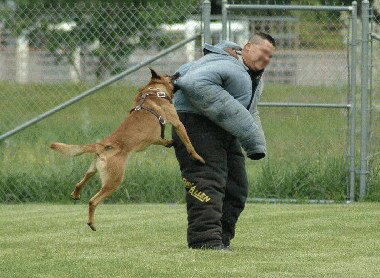DPO is an abbreviation for the German word "Diensthundpruefung" which, translated into English is "Service Dog Examination." In the German language, the term Service Dog means the same as the English term Patrol Dog. The DPO has been used for over 50 years as a performance standard for federal, state, and military agencies worldwide. This version is known as the "Baseline DPO." It is compatible for certification or competition.
- General Information
- There are two Titles a government Service Dog can achieve. They are DPO-1 and DPO-2. The Dog must be at least 14 months old for the DPO-1 and 18 months for the DPO-2. There must be at least six weeks between the DPO-1 and DPO-2 Trials. The Dog can participate in a Special Tracking Dog (FH or PFH) Trial providing it has a DPO-1 or other recognized Title.
- The DPO Trial is divided into three areas: Scentwork, Obedience-Agility, and Apprehension.
- The Dog achieves the DPO-1 if it acquires at least 70% of maximum points in each of the areas. The Dog achieves DPO-2 if it acquires at least 70% in Scentwork and Obedience-Agility, and at least 80% in Apprehension.
- The following evaluation scale provides a rating of the Dog's performance.
- 400-380 = Excellent (American "A" or German "V")
- 379-360 = Commendable (American "B" or German "SG")
- 359-320 = Good (American "C" or German "G")
- 319-280 = Satisfactory (American "D" or German "B")
- 279-240 = Insufficient (American "I" or German "M")
- 239-000 = Unsatisfactory (American "U" or German "U")
- When the Dog is heeling beside its Handler, it must automatically sit beside the Handler if the Handler halts, unless the exercise calls for a different behavior.
- Dogs that do not pass the Gunfire Test or the Courage Test are excused from the Trial at that point. All Dogs participating in the DPO Trial must be tested in these two exercises.
- Only very experienced tracklayers should be chosen for a DPO Trial, since it is difficult to present each Dog with similar tracking conditions.
- Tracks are to laid under the following conditions:
- The tracks are laid as evenly as possible.
- Articles, terrain changes, diversions, exits, and the proximity of the neighboring tracks must not be so close as to cause undue distractions to the Dog.
- The track should be laid using normal length steps and without any markers, except for a starting flag.
- Articles shall not be placed in holes or on hills.
- Articles shall be throughly permeated with human odor when placed along the track.
- The Judge shall be given a sketch of each track by the tracklayer and no other person shall have access to it.
- Only very experienced Agitators shall be used in a DPO Trial.
- The following criteria shall be critical:
- Equitable behavior shall be exhibited toward each Dog.
- Protective clothing worn by the Agitator should be as discreet as possible.
- The Agitator shall exhibit the same behavior toward each Dog, regardless of the Dog's response.
- The Judge shall instruct the Agitator on the specific behavior s/he wishes to be displayed.
- When multiple Agitators are used, if possible, each Agitator will act in the same role throughout the examination.
- When stick hits are administered, the Dog shall be struck only on the less sensitive parts of the body.
- The Agitator shall freeze in position when ordered by the Judge to do so.
- During any detain phase of the examination, the Agitator may turn and face a moving Dog.
- The Agitator shall avoid excessive swinging of the Dog when it is biting, as this is unnatural human behavior.







